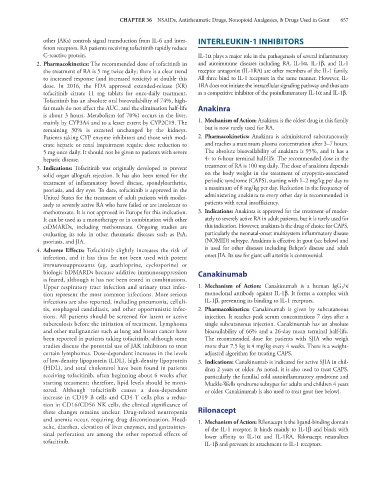Page 671 - Basic _ Clinical Pharmacology ( PDFDrive )
P. 671
CHAPTER 36 NSAIDs, Antirheumatic Drugs, Nonopioid Analgesics, & Drugs Used in Gout 657
other JAKs) controls signal transduction from IL-6 and inter- INTERLEUKIN-1 INHIBITORS
feron receptors. RA patients receiving tofacitinib rapidly reduce
C-reactive protein. IL-1α plays a major role in the pathogenesis of several inflammatory
2. Pharmacokinetics: The recommended dose of tofacitinib in and autoimmune diseases including RA. IL-1α, IL-1β, and IL-1
the treatment of RA is 5 mg twice daily; there is a clear trend receptor antagonist (IL-1RA) are other members of the IL-1 family.
to increased response (and increased toxicity) at double this All three bind to IL-1 receptors in the same manner. However, IL-
dose. In 2016, the FDA approved extended-release (XR) 1RA does not initiate the intracellular signaling pathway and thus acts
tofacitinib citrate 11 mg tablets for once-daily treatment. as a competitive inhibitor of the proinflammatory IL-1α and IL-1β.
Tofacitinib has an absolute oral bioavailability of 74%, high-
fat meals do not affect the AUC, and the elimination half-life Anakinra
is about 3 hours. Metabolism (of 70%) occurs in the liver,
mainly by CYP3A4 and to a lesser extent by CYP2C19. The 1. Mechanism of Action: Anakinra is the oldest drug in this family
remaining 30% is excreted unchanged by the kidneys. but is now rarely used for RA.
Patients taking CYP enzyme inhibitors and those with mod- 2. Pharmacokinetics: Anakinra is administered subcutaneously
erate hepatic or renal impairment require dose reduction to and reaches a maximum plasma concentration after 3–7 hours.
5 mg once daily. It should not be given to patients with severe The absolute bioavailability of anakinra is 95%, and it has a
hepatic disease. 4- to 6-hour terminal half-life. The recommended dose in the
3. Indications: Tofacitinib was originally developed to prevent treatment of RA is 100 mg daily. The dose of anakinra depends
solid organ allograft rejection. It has also been tested for the on the body weight in the treatment of cryopyrin-associated
treatment of inflammatory bowel disease, spondyloarthritis, periodic syndrome (CAPS), starting with 1–2 mg/kg per day to
psoriasis, and dry eyes. To date, tofacitinib is approved in the a maximum of 8 mg/kg per day. Reduction in the frequency of
United States for the treatment of adult patients with moder- administering anakinra to every other day is recommended in
ately to severely active RA who have failed or are intolerant to patients with renal insufficiency.
methotrexate. It is not approved in Europe for this indication. 3. Indications: Anakinra is approved for the treatment of moder-
It can be used as a monotherapy or in combination with other ately to severely active RA in adult patients, but it is rarely used for
csDMARDs, including methotrexate. Ongoing studies are this indication. However, anakinra is the drug of choice for CAPS,
evaluating its role in other rheumatic diseases such as PsA, particularly the neonatal-onset multisystem inflammatory disease
psoriasis, and JIA. (NOMID) subtype. Anakinra is effective in gout (see below) and
4. Adverse Effects: Tofacitinib slightly increases the risk of is used for other diseases including Behçet’s disease and adult
infection, and it has thus far not been used with potent onset JIA. Its use for giant cell arteritis is controversial.
immunosuppressants (eg, azathioprine, cyclosporine) or
biologic bDMARDs because additive immunosuppression Canakinumab
is feared, although it has not been tested in combinations.
Upper respiratory tract infection and urinary tract infec- 1. Mechanism of Action: Canakinumab is a human IgG /κ
1
tion represent the most common infections. More serious monoclonal antibody against IL-1β. It forms a complex with
infections are also reported, including pneumonia, celluli- IL-1β, preventing its binding to IL-1 receptors.
tis, esophageal candidiasis, and other opportunistic infec- 2. Pharmacokinetics: Canakinumab is given by subcutaneous
tions. All patients should be screened for latent or active injection. It reaches peak serum concentrations 7 days after a
tuberculosis before the initiation of treatment. Lymphoma single subcutaneous injection. Canakinumab has an absolute
and other malignancies such as lung and breast cancer have bioavailability of 66% and a 26-day mean terminal half-life.
been reported in patients taking tofacitinib, although some The recommended dose for patients with SJIA who weigh
studies discuss the potential use of JAK inhibitors to treat more than 7.5 kg is 4 mg/kg every 4 weeks. There is a weight-
certain lymphomas. Dose-dependent increases in the levels adjusted algorithm for treating CAPS.
of low-density lipoprotein (LDL), high-density lipoprotein 3. Indications: Canakinumab is indicated for active SJIA in chil-
(HDL), and total cholesterol have been found in patients dren 2 years or older. As noted, it is also used to treat CAPS,
receiving tofacitinib, often beginning about 6 weeks after particularly the familial cold autoinflammatory syndrome and
starting treatment; therefore, lipid levels should be moni- Muckle-Wells syndrome subtypes for adults and children 4 years
tored. Although tofacitinib causes a dose-dependent or older. Canakinumab is also used to treat gout (see below).
increase in CD19 B cells and CD4 T cells plus a reduc-
tion in CD16/CD56 NK cells, the clinical significance of
these changes remains unclear. Drug-related neutropenia Rilonacept
and anemia occur, requiring drug discontinuation. Head- 1. Mechanism of Action: Rilonacept is the ligand-binding domain
ache, diarrhea, elevation of liver enzymes, and gastrointes- of the IL-1 receptor. It binds mainly to IL-1β and binds with
tinal perforation are among the other reported effects of lower affinity to IL-1α and IL-1RA. Rilonacept neutralizes
tofacitinib. IL-1β and prevents its attachment to IL-1 receptors.

